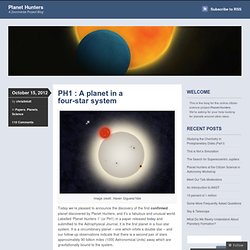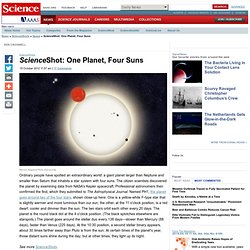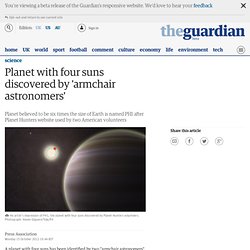

Planet with four suns discovered. 15 October 2012Last updated at 11:33 ET By Paul Rincon Science editor, BBC News website The new planet - a gas giant - is about six times the size of Earth Astronomers have found a planet whose skies are illuminated by four different suns - the first known of its type.

The distant world orbits one pair of stars which have a second stellar pair revolving around them. The discovery was made by volunteers using the Planethunters.org website along with a team from UK and US institutes; follow-up observations were made with the Keck Observatory. A report on the Arxiv server has been submitted to the Astrophysical Journal. Continue reading the main story “Start Quote Computerised attempts to find things [in the data] missed this system entirely. End QuoteDr Chris LintottOxford University The planet, located just under 5,000 light-years away, has been named PH1 after the Planet Hunters site. It is thought to be a "gas giant" slightly larger than Neptune - more than six times the radius of the Earth. Citizen Scientists Discover Four-Star Planet with NASA Kepler.
Kepler. PH1 : A planet in a four-star system « Planet Hunters. Image credit: Haven Giguere/Yale Today we’re pleased to announce the discovery of the first confirmed planet discovered by Planet Hunters, and it’s a fabulous and unusual world.

Labelled ‘Planet Hunters 1′ (or PH1) in a paper released today and submitted to the Astrophysical Journal, it is the first planet in a four-star system. It is a circumbinary planet – one which orbits a double star – and our follow-up observations indicate that there is a second pair of stars approximately 90 billion miles (1000 Astronomical Units) away which are gravitationally bound to the system. This is much closer than the nearest stars are to the Sun, so anyone viewing the sky from PH1 would have a spectacular view of all four stars. Planet Hunters. One Planet, Four Suns. Skip to main content Science/AAAS Subscribe Main menu You are here News » ScienceShots » Space » ScienceShot: One Planet, Four Suns Ken Croswell Share on facebookShare on twitterShare on redditMore Sharing ServicesShare on email ScienceShots.

Unprecedented: Amateur astronomers discover a planet with four suns. False.

At least in understanding, suns can be anywhere, Sol is the name of the star we orbit. Take your innacurate indignation elsewhere I thought we were in the Sol system? From what I've observed, a 'sun' is a title we give a star in relation to objects in its system, such as how we call large satellites 'moons'. It used to bother me that we'd call them suns, but the more I think about it, the more it makes sense to me that we can use it as a relative term such as 'ground' and 'sky'.
[1210.3612] Planet Hunters: A Transiting Circumbinary Planet in a Quadruple Star System. Amateur planet hunters find a world with a four star rating. A new exoplanet – a planet outside our own solar system – has been found, and it’s pretty cool for two reasons: it was found by amateur planet hunters, and it’s in a four-star system!

OK, first, the planet: called PH-1, it’s bigger than Earth, about six times our radius, or about half the diameter of Jupiter. The mass isn’t well known, but may be as high as 170 times our own mass, though far more likely it’s closer to 20 – 50 times our mass. That makes it closer physically to Uranus and Saturn than Earth, so it’s likely a gas giant. It’s also hot, with a probable cloud-top temperature of 400+ Celsius (800+° F). Even if it has Earth-sized moons they’re likely to be too hot to be hospitable. But the more interesting thing about this planet is its host stars: PJK-1 orbits a binary star, two stars that orbit each other (like Tatooine, if you like).
Kepler finds a planet in a binary star’s habitable zone. Oh, this is too cool: scientists have found a planet orbiting a binary star (a pair of stars in tight orbit around each other) that is at the right distance to have liquid water!

Let me be clear: this planet is much bigger than Earth, and is likely to be a gas giant. So it’s not Earth-like, and probably not itself habitable. But it might have moons… [Note: this image is artwork based on the science. Click to tatooineneate.] Planets with Four Suns? Planet with four suns discovered by 'armchair astronomers'
A planet with four suns has been identified by two "armchair astronomers".

The bright new world, almost 5,000 light years away, is believed to be six times the size of Earth. It orbits one pair of stars and is in turn circled by a second pair, meaning four stars light up its skies. A handful of planets are already known to orbit pairs of binary stars, but the new find is said to be unique. "It's fascinating to try and imagine what it would be like to visit a planet with four suns in its sky, but this new world is confusing astronomers – it's not at all clear how it formed in such a busy environment," said Dr Chris Lintott, of Oxford University. The planet was discovered by two American volunteers using the Planet Hunters website run by scientists including Lintott. Kian Jek, from San Francisco, and Robert Gagliano, from Cottonwood, Arizona, spotted the effect as the new planet passed in front of its suns. Planet with four suns discovered - Science - News. The bright new world, just under 5,000 light years away, is believed to be six times the size of Earth.

New planet with four suns identified by 'armchair astronomers' Planet With Four Suns Discovered By 'Armchair Astronomers'